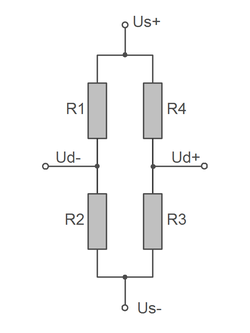Basics of Wheatstone bridge circuit
 |
The two connections Us+ and Us- are used to supply the bridge circuit. Us- The voltage between Us+ and Us- is also referred to as bridge supply voltage Us or bridge supply or sensor input. Us- is connected to ground GND in many measuring amplifiers. |
The voltage change is measured via the terminals Ud+ and Ud- when the bridge circuit is detuned due to strain on one or more strain gauges.
The voltage between Ud+ and Ud- is called "differential voltage Ud" or "bridge output" or "sensor output".
The bridge circuit is balanced (the voltage between Ud+ and Ud- is 0 V) when the following condition is met:
The bridge circuit is usually powered with a direct voltage of 5V.
